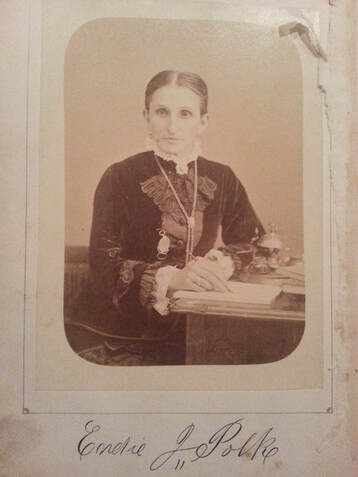The best protection any woman can have … is courage -- Elizabeth Cady Stanton  Daisy's mother, Endemial Josephine Drane Polk was no wilting southern belle. And although she was a daughter of the south, she held no allegiance to any of the rules or tenets of that society. Known to family and friends as Endie or EJ, she was born in St. Louis on April 13, 1835, the daughter of Reverend TJ Drane and Susan Keith. In 1854, at 19 she married her first husband Ferdinand Leonard Burch. On the heels of this marriage at 25 the war of the states began. And by her 30th birthday she was a war widow with 3 children (only one surviving to adulthood). By the end of the civil war at age 32, she remarried Willis Webb Polk a fellow widower and father to 2 children, only William survived to adulthood. She and Willis had 5 children (Trusten born after Daisy did not survive to adulthood) Following the Civil War, the Polk's moved from Kentucky in search of work and greater stability. The war had ended a lucrative architecture and building practice for Willis Webb and a builder needs to go where Cities are being built.. The family moved frequently and followed opportunities. From Illinois to St Louis, Kansas City, Hot Springs Arkansas back to St Louis until moving west for a brief time in Los Angeles and finally San Francisco is 1892. EJ managed European style Hotels in many of these locales. Most notably the Hotel Hunt in St Louis, The Williard Hotel in Kansas City and the Hotel Josephine in Hot Springs, Arkansas. The hotels also served as offices for Polk & Sons Architects and Builders. EJ was listed as the Proprietor and managed day to day operations.
Among other things, EJ wrote for the St Louis Post Star Gazette. She was a published author. Gems and Husks were books of her writings and poetry that sat proudly in the family drawing room. And despite, or because of, her southern roots, she was a staunch abolitionist. She was a devoted follower of the leading suffragists at the time - Elizabeth Cady Stanton and Susan B. Anthony. While she never lived long enough to see women get the vote, she did see an end to slavery. EJ was one of several who founded the St Louis Chapter of The National Women’s Suffrage Association with Virginia Minor and Susan B. Anthony, serving as delegate at 2 national conventions. Of note, the League of Women Voters was formed as a continuation of the St Louis Chapter's work after the 19th Amendment to the U.S. Constitution passed by Congress June 4, 1919, and ratified on August 18, 1920, granted women the right to vote. Endie and others who founded the Chapter are recognized among St Louis' State Roll of Honor as women who have rendered distinguished service in winning suffrage for women. Their names were placed on a bronze tablet at the National League of Women Voters headquarters in Washington D.C. Historically, St. Louis was the birthplace of the League of Women Voters. In March 1919, the National American Women’s Suffrage Association held its Jubilee Convention in St. Louis. At this convention, Carrie Chapman Catt, President of the organization, called for the members to "raise up a League of Women Voters." The delegates agreed but formal organization was delayed until February 1920. The Missouri League of Women Voters came into formal existence in October 1919 and thus predated the National League by several months. St Louis was a major transportation hub and a prosperous city when Daisy lived there. Missouri saw a huge influx from the South despite it being a slave state during the Civil War. St. Louis became connected to the rest of the country by railroads soon after the end of the war. Thanks in great part to Ethel Crocker's grandfather Charles Crocker (of the Big Four). Rail traffic rapidly replaced river traffic. The Eads Bridge, which Willis recalled being built with great fondness, first carried rail traffic across the Mississippi in 1874. St. Louis Union Station was, when it opened in 1894, the largest single-level passenger train terminal in the world.
1 Comment
Ali Walecka
7/21/2020 07:54:16 am
What a fantastic tidbit about the challenges of living during this period. Ends and Daisy definitely rose to the occasion!
Reply
Your comment will be posted after it is approved.
Leave a Reply. |
Some stories that couldn't make the book in full ... but need to be told! Editors welcomed - sign up below.
STORIES
WR HEARST PLANS SONG: DAISY HOT SPRINGS 1882 A WILLIS POLK GIFT THE RLS CONNECTION 1896 EARTHQUAKE TALES FROM COPPA PANDEMIC OF 1889 THE BOMB THAT SHOOK SF MILAN:CITY OF WATER POLK ON THE MAP FEATHERS, FASHION & FLY FISHING RARE AVIATION FILM - WWI 1914-17 1906 SAN FRANCISCO WTF FILES - TECHNOLOGICAL GET ME OUTTA HERE! NO HORSES, NO TENTS, NO $ DAISY IN FRENCH LITERATURE DAISY ON FILM! THE WHITE DEATH THE SYMBOLISM OF FLOWERS POSTE DE SECOURS WWI TRAVEL 1900: LONDON TO PARIS DAISY: REST IN PEACE KEITH'S, DRANE'S & KENTUCKY MOTHER: MISSOURI COMPROMISE Topics
All
|

 RSS Feed
RSS Feed